Baseball Performance Under Pressure #1
What is Choking and Why Does it Happen?
“90 percent of the game is mental. The other half is physical.”
– Yogi Berra
Nearly every baseball coach, parent, and player is aware of this famous Yogi Berra quote. And, despite how mathematically incorrect it may be, it accurately symbolizes the importance of the mental component of the game.
Discussing the relevance of a strong “mental game” with respect to optimal performance isn’t breaking news. There’s an abundance of resources spread throughout the internet that superficially glean over the subject. All you have to do is type in some buzzwords like ‘diaphragmatic breathing’ & ‘mindfulness meditation’ + baseball and see what pops up.
But for whatever reason, and certainly not stemming from a paucity of literature, there is very little public attention to the details, the science, and the why of mental fortitude. We tell our players to ‘relax’ and ‘reset’, when we haven’t really established what that means, or why it’s important. And, even worse, we sometimes neglect the cognitive and affective aspects of athletic development to the detriment of our players.
In a recent article, we took a brief look at the word, “capacity”, and what it means for sports performance and injury resilience. Within the four subcategories of capacity we proposed, psychological capacity is perhaps the most poorly understood, and least discussed in our sport, particularly when it comes to preparation.
We have loosely defined psychological capacity as:
“The ability to maintain appropriate arousal levels, rapt attention to relevant environmental stimuli, and unwavering intention towards task goals, amid the dynamic in-game conditions and emotions that afflict the athlete during competition.”
A clarification: Please note that, as we dive deeper into psychological capacity, we are not talking about “Baseball IQ” (i.e. the understanding of baseball strategy and/or the correct responses to in-game situations). Although “Baseball IQ” may directly affect how well an athlete performs under pressure, it is beyond the scope of this article. Topics relating to baseball strategy will be much better addressed by skill coaches than what we can offer as a performance therapist or physical preparation coach.
Coming to a definition is a good first step, but what actually happens to a player if his/her psychological capacity is outmatched by situational demands? As movement practitioners, we are particularly interested in the effects anxiety has on skilled movement, performance and how what we can do about preventing it.
As we progress through this post, and the ones to follow, I want you to keep one thing in mind. As Dr. Keith Lohse has stated in his work, when it comes to attention and motor performance, a good mantra to live by is, “it’s a bit more complicated than that.” The evidence, ideas, and research addressed in the following blog posts are not the end-all be-all, but part of a theoretical construct for how attention might influence the motor system. Nothing is as simple as statements like “internal cueing is always wrong”, or “just relax and focus”. As you’ll soon read, “it’s a bit more complicated”.
Psychological Capacity and Motor Variability
It is first essential for us to be on the same page about two key movement principles; the concepts of degrees of freedom and movement variability. We have previously talked about these topics in great depth in our our webinar Dynamic Systems Theory and in Tavis Bruce’s post on Pitch Mechanics 101 “How We Move”. (If you’re already familiar with this information then feel free to skip ahead to the next section)
In 1968, Nikolai Bernstein first posed the Degrees of Freedom Problem (DOF) in which he questioned “how can the human motor system co-ordinate the redundant number of available options for movement?”
Put into baseball relevance — given the infinite number of ways we can move our shoulder, elbow, and other joints in the kinetic chain, how does our body co-ordinate them to smoothly deliver a pitch to home plate?

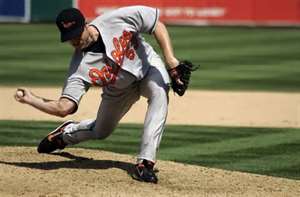
These two pitchers have the same task in mind — hit the catcher’s target — but they obviously organize their limbs in different ways to achieve the movement goal.
In his now infamous experiment, Bernstein uncovered that when given the task of striking an iron target with a hammer, expert blacksmiths consistently executed the task, yet were inconsistent in how they did so. That is, how they coordinated their limbs to produce the desired outcome was never the exact same from trial to trial. There was variability in how they got there! A concept that Bernstein called ‘repetition without repetition.’
This essentially tells us that even though we can consistently hit the target with a fastball, the way in which our limbs will co-ordinate to do so will always vary from throw to throw. This is what motor control theorists call ‘coordinative variability’, and it is generally a reflection of a healthy system.
How our body organizes movement is largely dictated by the constraints placed on it – what can be thought of as boundaries or limitations imposed by the environment, the task and the organism itself.
Imagine how different we would ‘co-ordinate’ our mechanics given the boundaries of a flat-ground bullpen versus one on a 20 degree incline mound.
It follows that patterns of movement must be flexible enough to adjust to fluctuations and changes to these constraints.
Consider how a hitter makes an adjustment mid-swing, for example when they recognize and then have to square up an off-speed pitch.

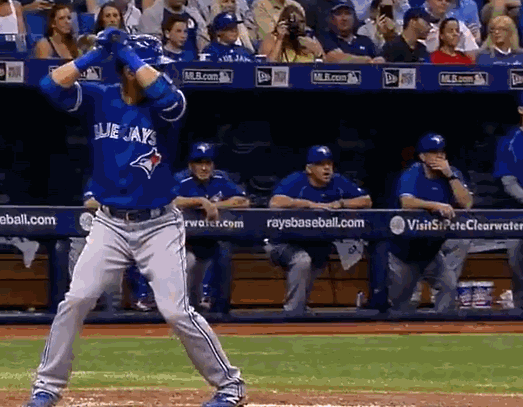
Thanks to Dustin Lind‘s incredible collection of GIFs.
Major league ABs are incredible displays of ‘flexible’ patterns. Recognizing and adjusting to pitches is a great display of how the movement pattern (swing) must be able to accommodate for dynamic changes in the task (hit the ball).
Jerry Brewer has an excellent webinar on the subject of dynamic systems theory and hitting that explores this topic in great detail. I would highly recommend watching if you haven’t done so already.
When a movement pattern becomes less able to compensate for the dynamic nature of the constraints placed on it, it is said to be rigid. What results is a motor system that is less capable of handling changes in the environment, the task and the organism itself.
Takeaways:
- To execute a desired movement, the body needs to coordinate the infinite number of available degrees of freedom
- How our body coordinates movement is a result of the constraints placed on it
- No two movements will ever be the exact same
- A healthy system is characterized by large coordinative variability
Choking Under Pressure
Now that we have gotten through some key movement principles, we can return to the topic at hand. Choking under pressure.
An obvious place to begin this journey would be to clearly outline a few definitions. Mainly, the distinction between choking, slumping and the yips.
Choking is the process in which a performer underperforms in a high pressure situation relative to their own abilities. It is a process that must occur within a discrete and discernible time period or state.
Slumping on the other hand, may perhaps inflict similar mechanisms as choking, yet it occurs without an easily identifiable or discrete onset and ending. We can’t pinpoint when an athlete begins a slump or ends one. Moreover, slumping isn’t necessarily correlated with high pressure situations.
Both choking and slumping are considered to be different concepts from the yips:
“the debilitating movement disorder characterised by the production of perceived involuntary movements (often described anecdotally as ‘jerks’, ‘tremors’, ‘spasms’ and ‘twitches’) that occur during the course of executing a motor behaviour requiring fine control” (Glazier 2009).
The literature on the yips, primarily stemming from the observation of golfers, does not point to a conclusive pathophysiology. Rather, most academics believe that it is a byproduct of an underlying process on a spectrum between focal dystonia and pressure induced anxiety. While the yips may result in a player choking, it is not a requirement. One can certainly choke without displaying a jerk, tremor, or twitch and vice versa.
As we will elaborate further in a future post, the act of choking presents some interesting physical manifestations including changes to movement execution, variability and performance. But for now, let’s get into some of the prevailing thoughts on why this choking process occurs.
Why Do Athletes Choke? A Review of Popular Theories.
Despite the rather significant effects of pressure and anxiety on human performance, the underlying mechanisms behind choking behaviour are not fully worked out yet. Three prominent theories pervade, broken down into two categories; Drive Theory and Attentional Models.
Drive Theory of Choking
Drive theories of choking center around the arousal-incentive relationship. That is, the greater the incentive, the higher our arousal levels, and therefore the better that we perform.
The first drive theory came out of the Yerkson-Dodson Effect, which posited that decreased performance is elicited by increased arousal, facilitated by either high incentives or social pressure. Also known as the Inverted-U theory, it suggested that performance increases to an optimal arousal level and then slowly declines thereafter. It suggests that there’s a sweet spot for how jacked up we should be at the plate to hit dingers.
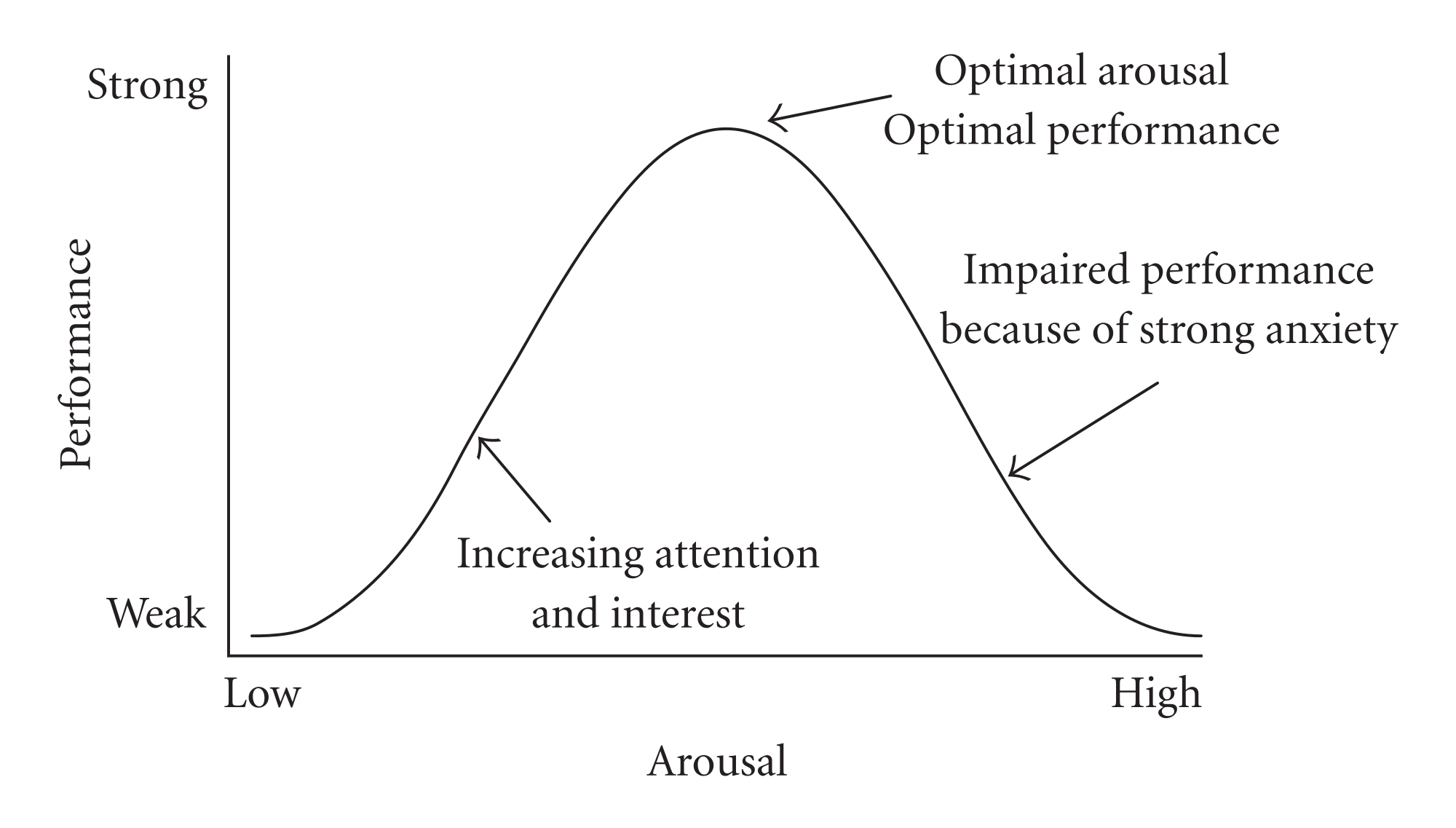
The main criticism of this theory, however, is that the proposed steady decline in performance above this sweet spot doesn’t really exist in sport. To reconcile this issue, Hardy et al proposed a sport variant of the Cusp Catastrophe Model (CCM). Whereas the Inverted-U predicted a steady and predictable decline in performance, the CCM proposed that pressure beyond a threshold of optimization would produce catastrophic results.
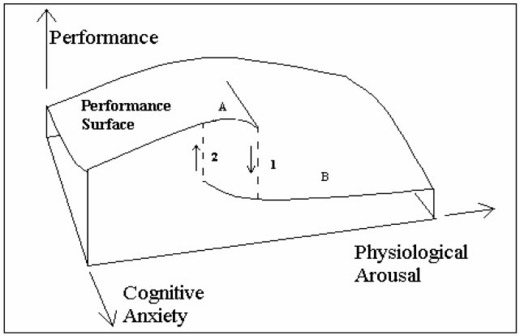
As opposed to the pleasant ski slope-like of the Inverted-U, the descending portion of the curve would look more like a cliff! Think of a pitcher being so fired up at the end of the game that he rushes his delivery and becomes erratic. Beyond a certain level of excitation, even a small increase would create a catastrophic degradation to performance. This sounds eerily similar to what Dynamic Systems Theory describes as a sudden phase state transition.
Another important component to Drive Theory, Zajonc’s Social Facilitation theory, links arousal levels to common social settings in sports. It suggests that the mere presence of people viewing a performer can create an atmosphere of evaluation and heightened arousal. That is, there is a greater likelihood of a player being ‘jacked up’ in front of a crowd. This concept is often used to induce pressure situations in a lab setting, and will be a key piece when we talk about protecting ourselves from choking in a future post.
Overall, drive theories have come under scrutiny by a number of researchers. As Gray and Beilock pointed out, they fall short for the following reason:
“First, drive theories are more descriptive than prescriptive. That is, drive theories link arousal and performance, but they do not explain how arousal exerts its impact. Second, […] there are often debates concerning how the notion of arousal should be conceptualized (e.g., as a physiological construct, emotional construct, or both). Third, […] there are situations in which certain drive theories have trouble accounting for observed behavior.”
For these reasons, experts in this field tend to lean towards Attentional Models when explaining choking. Rather than focusing on arousal levels, these models focus on where a performer directs his or her attention in high pressure situations.
There are two main prevailing Attention Models for choking, Distraction Theory and Explicit Monitoring Theory.
Attentional Model #1: Distraction Theory
Distraction Theory states that pressure scenarios create a distracting environment thereby drawing a player’s attention away from executing the task at hand. Performers shift their focus to task-irrelevant thoughts and ideas — like worrying about the consequences of striking out or walking a batter. In cases where working memory is heavily relied upon, completing a busride Sudoku puzzles, a shift in attention essentially turns a single task — a single focus — into a dual task. As a consequence, working memory is divided between two competing energy camps and overall performance suffers.
Having said that, it should be noted that Distraction Theory may not apply to highly skilled movements where procedural memory is the prominent system, specifically in some of the sporting movements that have been studied in the literature (e.g., golf putting, hitting a baseball). For example, after years of practice throwing a baseball, it is believed that this movement becomes a proceduralized or automatic skill. It’s a process that doesn’t require immediate attentional focus, and therefore relies very little on working memory (Beilock, Carr, et al 2002).
If that is the case then it is possible that distraction may not be the only theory for choking in baseball, leading us to…
Attentional Model #2: Explicit Monitoring Theory
First proposed by Baumeister in 1984, Explicit Monitoring Theory centers around the notion that pressure inducing situations have a tendency to shift an athlete’s focus internally towards the specific steps involved in skill execution.
When a novice first begins the process of learning a new skill or movement, they are typically taught in a manner that is explicitly and overtly outlined in a step-by-step fashion. Think about how most coaches break down the pitching motion to beginners.
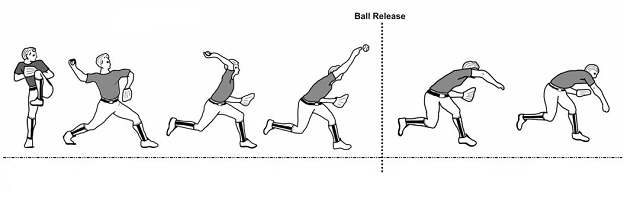
“Rock back, turn your foot, bring your knee up, swing your arm”.
These steps are learned as a specific set of rules and stored under our conscious awareness. After enough practice they can be transferred from explicit to implicit knowledge and become fast, automatic and below conscious access.
Explicit Monitoring Theory posits that when an athlete is anxious they become more self-aware of how they are performing, bringing attention to the explicit steps they learned as novices. This step-by-step focus on execution, also described by Masters in his Reinvestment Theory as ‘dechunking’, interrupts the normally automatic process of skill execution. Each step needs to be executed independently, slowing down the process and allowing for more opportunity for things to go wrong.
For those familiar with their attention research, Wolf and Prinz extensively detailed this phenomena in their pioneering work in 2001, appointing it the ‘constrained action hypothesis’. They believed that when an athlete shifts their attention inwards, they are no longer allowing for automatic and smooth movement. They become more error prone by ‘intervening’ in their otherwise automatic execution of a skill.
It is possible that both attentional models can contribute to the degradation of performance. For example, switching from implicit to explicit attention could require the brain to more heavily rely on working memory. And considering pressure consumes our capacity for working memory, it will further deplete the attentional resources needed to do the task in a “step-by-step” way (Guicciardi et al 2010).
We will return to Explicit Monitoring Theory and some insightful work in it’s relation to baseball by Rob Gray in a future post!
The Biopsychosocial Model of Challenge and Threat
Intuitively we know that certain athletes perform better under pressure than their equally-skilled compatriots (albeit contrary to some of the previously mentioned theories). There are players that seem to naturally thrive in scenarios where others would crumble. Indeed, research examining the effect of stress on performance has demonstrated considerable variability in performance between individuals under psychological stress, owing mainly to their variability in perception of stress.
One of the prominent theories on why this occurs, presented by Blascovich is called the Biopsychosocial Model (BPSM) of challenge and threat. According to the BPSM, individuals analyze the demands of the task, consciously or unconsciously, and evaluate whether or not they possess the adequate resources to accomplish it. These resources aren’t limited to just skill, knowledge, and abilities, but also reflect previous experiences, psychological and physical danger, familiarity, uncertainty, and the presence of others (Blascovich, 2008).
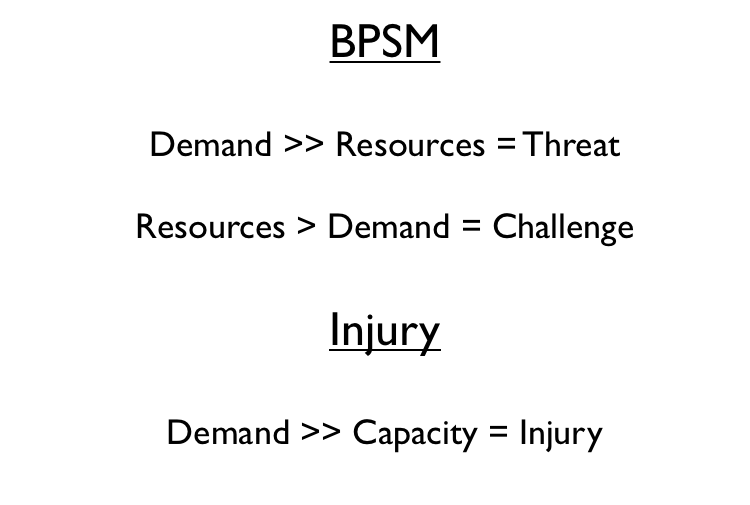
When an individual evaluates that they have the adequate resources necessary to successfully complete the task, they will assume what is termed a challenge state. If they evaluate otherwise, they will assume a threat state. The state of the performer may have a profound effect on the focus of their attention, directed to either task-relevant cues in a challenge state or task-irrelevant cues in a threat state (Jones, 2009). This of course lends favour to the previously mentioned Reinvestment Theory.
In a study in 2012, Moore et al. investigated the short term effects challenge and threat states had on performing novel movements. The authors found that novice participants in a challenge state performed better, showed movement patterns consistent with expert performers, and displayed a longer quiet eye (remember this for later!) than those who were in a threat state. Although this study poses a number of limitations and therefore generalizations are difficult to make, it was the first study that investigated the immediate effects of a challenge versus threat state.
Interestingly, BPSM mirrors the research on ‘Flow State’ by Mihaly Csikszentmihalyi. He found that achieving optimal performance requires a performer to very closely match a task’s level of challenge with their level of skill.
Although it has been proposed that the process of assessing threat versus challenge can potentially be a conscious one, most studies and experts argue it to be automatic. That is, evaluation will proceed under the level of conscious awareness. Because of this, the best way to index whether or not a player falls into a threat or challenge state is to analyze objective measures of stress states such as endocrine and cardiovascular responses.
Regardless, the idea of analyzing the perceived demands to resources prior to a task is a fascinating one, and may help guide us on how to protect ourselves from choking.
Summary
As we have outlined in our first look at psychological capacity, there is no definitive causative theory on why performers succumb to choking under pressure. In all likelihood it is a combination of the three prevailing theories, leaning more towards Attentional Models, that compose our best guess. In the next post, we will examine the role that anxiety plays in the execution of skilled movements and its affect on performance.
Takeaways:
- Choking is a separate and distinct entity from slumping and the yips
- There is no definitive pathophysiology to explain choking
- Drive Theory focuses on arousal levels and explains how social pressure can heighten anxiety
- Attentional Models, including Distraction and Explicit Monitoring Theories, propose that a shift in an athlete’s attention is responsible for choking
- The BPSM attempts to reconcile which athletes choke from an unconscious analysis of capacity versus demand
I hope that this post has sparked some insight, opened further inquiry, and future discussion. It’s a fascinating topic and one in which the research continues to add each to every week. In the next post, I will attempt to clarify what happens to movement and under pressure situations and relate it back to pain, injury and performance.
Dr. Stephen Osterer
